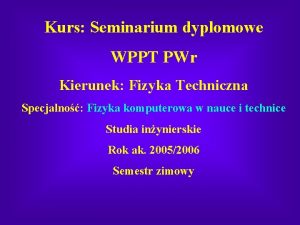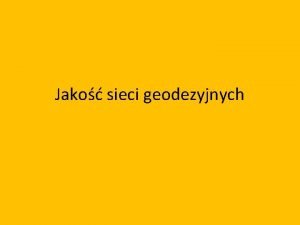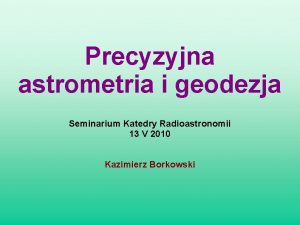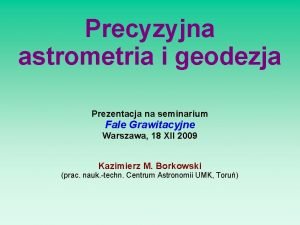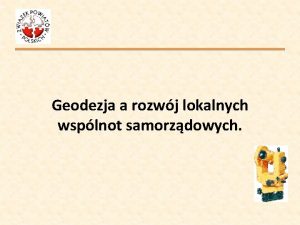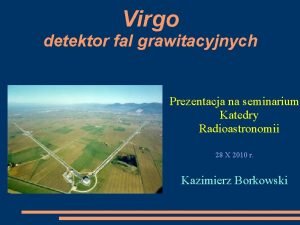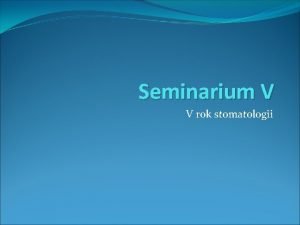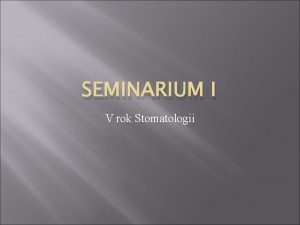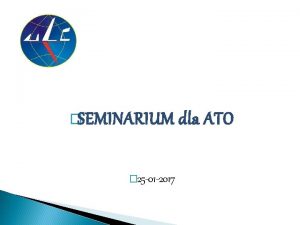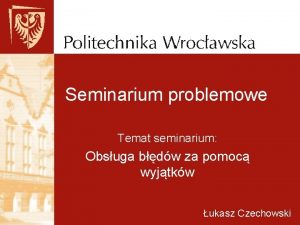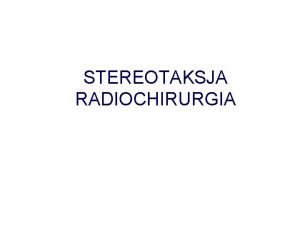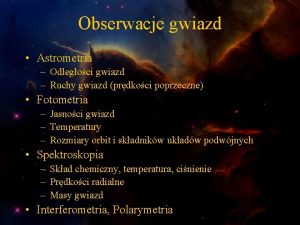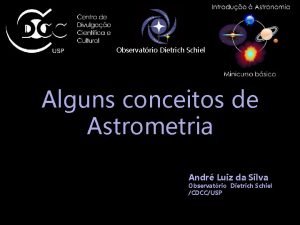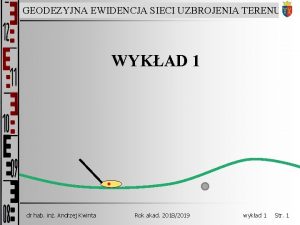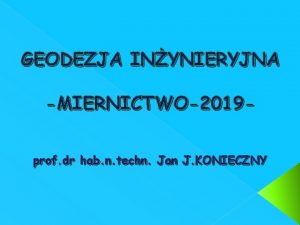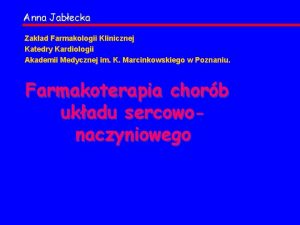Precyzyjna astrometria i geodezja Seminarium Katedry Radioastronomii 13





























- Slides: 29

Precyzyjna astrometria i geodezja Seminarium Katedry Radioastronomii 13 V 2010 Kazimierz Borkowski

Techniki i dokładności pomiarów Układy odniesienia na niebie (ICRF) ICRF(1) i jego rozszerzenia ICRF 2 – katalog radioźródeł (2010) Przykłady pomiarów baz VLBI Ziemski układ odniesienia (ITRF) Ruchy stacji pomiarowych Ruchy względem płyt tektonicznych (świat, Europa, Włochy) Produkty IVS/IERS Nutacja Ruchy bieguna Ziemi UT 1 – UTC Sekunda przestępna

Geodetic VLBI Network IERS TN 34



ICRF 2 VLBI Catalogue of Compact Radio Sources The Second Realization of ICRS ICRF is currently defined by radio positions of 295 extragalactic objects. The ICRF 2 catalogue is the most complete. It includes 3414 (295+922+2197) sources sufficiently observed with astrometric and geodetic VLBI from August 1979 to March 2009. On 13 August 2009 it has been adopted by the IAU as the fundamental realization of the ICRS effective 1 January 2010. IERS Technical Note No. 35 (2009), 1 -204 http: //www. iers. org/Main. Disp. csl? pid=46 -1100252



Positions by sessions Semi-annual positions IERS Annual Report 2006 http: //www. iers. org/Main. Disp. csl? pid=47 -1100232



Leonid Petrov GSFC (2007)

http: //itrf. ensg. ign. fr/GIS/index. php

http: //itrf. ensg. ign. fr/ITRF_solutions/2005/ITRF 2005. php






0. 1” = 3. 1 m www. iers. org/Main. Disp. csl? pid=47 -1100232

www. iers. org/nn_11252/IERS/EN/Data. Products/Earth. Orientation. Data/__Function/Plots__EOP 05 C 04__1980/generische. Tabelle__Diagramm. html

INTERNATIONAL EARTH ROTATION AND REFERENCE SYSTEMS SERVICE (IERS) SERVICE INTERNATIONAL DE LA ROTATION TERRESTRE ET DES SYSTEMES DE REFERENCE SERVICE DE LA ROTATION TERRESTRE OBSERVATOIRE DE PARIS 61, Av. de l'Observatoire 75014 PARIS (France) Tel. : 33 (0) 1 40 51 22 26 FAX : 33 (0) 1 40 51 22 91 Internet : services. iers@obspm. fr Paris, 14 January 2010 Bulletin C 39 To authorities responsible for the measurement and distribution of time INFORMATION ON UTC - TAI NO positive leap second will be introduced at the end of June 2010. The difference between Coordinated Universal Time UTC and the International Atomic Time TAI is : from 2009 January 1, 0 h UTC, until further notice : UTC-TAI = -34 s Leap seconds can be introduced in UTC at the end of the months of December or June, depending on the evolution of UT 1 -TAI. Bulletin C is mailed every six months, either to announce a time step in UTC, or to confirm that there will be no time step at the next possible date. Daniel GAMBIS Head Earth Orientation Center of IERS Observatoire de Paris, France

Plik eopc 04. 10 INTERNATIONAL EARTH ROTATION AND REFERENCE SYSTEMS SERVICE EARTH ORIENTATION PARAMETERS EOP (IERS) 05 C 04 FORMAT(2 X, A 4, I 3, 2 X, I 5, 2 F 9. 6, F 10. 7, 2 X, 2 F 9. 5) ************************************** Date MJD x " y " UT 1 -UTC s LOD s d. Psi " d. Epsilon " (0 h UTC) YEAR ==> 2010 JAN 1 JAN 2 JAN 3 JAN 4 JAN 5 JAN 6 JAN 7 JAN 8 JAN 9 JAN 10. . MAY 3 MAY 4 MAY 5 MAY 6 55197 55198 55199 55200 55201 55202 55203 55204 55205 55206 0. 098699 0. 096620 0. 094672 0. 092742 0. 090534 0. 087614 0. 084286 0. 081189 0. 077948 0. 074207 55319 -0. 069570 55320 -0. 068338 55321 -0. 066684 55322 -0. 064813 0. 192933 0. 193281 0. 193176 0. 193498 0. 193817 0. 194172 0. 194357 0. 194463 0. 194595 0. 194442 0. 1140681 0. 1134412 0. 1125138 0. 1113750 0. 1100189 0. 1086128 0. 1073321 0. 1062497 0. 1054009 0. 1048169 0. 0005535 0. 0007867 0. 0010581 0. 0012723 0. 0014088 0. 0013349 0. 0011575 0. 0009793 0. 0007337 0. 0004847 -0. 06385 -0. 06359 -0. 06377 -0. 06413 -0. 06435 -0. 06438 -0. 06452 -0. 06475 -0. 06500 -0. 00490 -0. 00495 -0. 00516 -0. 00550 -0. 00564 -0. 00550 -0. 00528 -0. 00515 -0. 00517 0. 393453 -0. 0244010 0. 395437 -0. 0249163 0. 397447 -0. 0254621 0. 399755 -0. 0262276 0. 0005698 0. 0005596 0. 0005881 0. 0007231 -0. 06144 -0. 06165 -0. 06184 -0. 06179 -0. 00998 -0. 00992 -0. 01001 -0. 01018

http: //maia. usno. navy. mil/ser 7. dat *********************************** * * * I E R S B U L L E T I N - A * * Rapid Service/Prediction of Earth Orientation * *********************************** 6 May 2010 Vol. XXIII No. 018 ___________________________________ PREDICTIONS: The following formulas will not reproduce the predictions given below, but may be used to extend the predictions beyond the end of this table. x = y = 0. 0762 - 0. 0434 cos A + 0. 1053 sin A - 0. 0912 cos C - 0. 0452 sin C 0. 3501 + 0. 0952 cos A + 0. 0372 sin A - 0. 0452 cos C + 0. 0912 sin C UT 1 -UTC = 0. 0084 - 0. 00086 (MJD - 55330) - (UT 2 -UT 1) where A = 2*pi*(MJD-55322)/365. 25 and C = 2*pi*(MJD-55322)/435. TAI-UTC(MJD 55323) = 34. 0 The accuracy may be estimated from the expressions: S x, y = 0. 00068 (MJD-55322)**0. 80 S t = 0. 00025 (MJD-55322)**0. 75 Estimated accuracies are: Predictions 10 d 20 d 30 d 40 d Polar coord's 0. 004 0. 007 0. 010 0. 013 UT 1 -UTC 0. 0014 0. 0024 0. 0032 0. 0040 MJD x(arcsec) y(arcsec) UT 1 -UTC(sec) 2010 5 7 55323 -0. 0634 0. 4021 -0. 02698 2010 5 8 55324 -0. 0620 0. 4046 -0. 02800 2010 5 9 55325 -0. 0607 0. 4070 -0. 02915. . . . 2011 5 4 55685 0. 0062 0. 3309 -0. 30096 2011 5 5 55686 0. 0063 0. 3322 -0. 30191 2011 5 6 55687 0. 0063 0. 3334 -0. 30275 These predictions are based on all announced leap seconds.


3 cm = 1 mas

Hipparcos Celestial Reference Frame Launched in August 1989 Hipparcos successfully observed the celestial sphere for 3. 5 years before operations ceased in March 1993. The Hipparcos catalogue contains 118, 218 stars. The positional accuracies of 1 to 3 mas at epoch 1991. 25 are unsurpassed in the optical. Proper motion accuracies, of around 1 to 2 mas/yr, remain state of the art. Thus typical positional errors at a 2005 epoch are around 15 mas. The Tycho 2 Catalogue, completed in 2000, contains 2, 539, 913 stars. Positional accuracies range from about 10 to 100 mas, depending on magnitude. Proper motion accuracies are from 1 to 3 mas. Over 10 years after the successful Hipparcos mission a first attempt was made to improve upon the original link between the HCRF and the extragalactic ICRF (Bobylev et al. , 2004). The possible error in the alignment between the 2 systems increases with time, approaching about 3 mas estimated standard error per axis at the 2005 epoch.

SIM-Planet Quest • Synopsis: SIM Planet Quest is a space-based optical interferometer operating in a near Earth-trailing orbit • Acronym: Space Interferometer Mission • Funding Agency: NASA • Launch: 2015 (plan). Five year baseline mission, potential ten year extended mission • Con. Ops: SIM Planet Quest is a pointed mission with predefined targets • Number of Objects: about 10, 000 stars (1, 300 grid stars) • Magnitude Range: brighter than (a limiting magnitude of) about 20 th • Astrometric Accuracy: 4 microarcseconds wide angle, 1 microarcsec. narrow angle • Reference Frame: Should SIM achieve 4 microarcseconds wide angle astrometric accuracy, the resultant grid will form the basis of the most accurate reference frame ever produced, easily exceeding the accuracy of the current radio-based ICRF. SIM will also be capable of observing a fair number of extragalactic sources. Detailed plans are currently being developed with regard to SIM observations of the extragalactic frame sources. • Additional Information: SIM Planet quest is currently in mission development Phase B (Preliminary Design phase). http: //planetquest. jpl. nasa. gov/SIM

Gaia • Synopsis: Gaia is a funded space astrometry mission intended to launch in 2012 Operating at L 2, Gaia consists of three instruments which provide astrometric, photometric, and spectroscopic data • Funding Agency: ESA • Launch: August 2012. Five year operation phase • Con. Ops: Continuous scanning. Two optically combined fields of view • Number of Objects: 10^9 • Magnitude Range: 7 -20^th magnitude • Astrometric Accuracy: 15 -20 microarcseconds @ 15^th m_v • Reference Frame: The stated accuracy goal of Gaia is somewhat less than that of SIM-Planet. Quest. What Gaia loses in accuracy, however, is easily overcompensated in the number of mission objects, of order 10^5 more than SIM-Planet. Quest. Gaia will also detect and measure the positions of about 400, 000 QSOs, enabling an extremely rigid attachment of the impressively dense Gaia stellar frame to the extragalactic frame • Additional Information: In addition to astrometry, Gaia will provide 12 band millimagnitude photometry, radial velocity data for brighter stars to an accuracy of a few km/s and spectrophotometry in the visible and near-IR to mv 17. 5 http: //www. rssd. esa. int/gaia/

